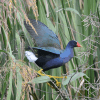 Hi Folks,
Hi Folks,
I’m near the Canadian Border with my group but still have loads of pictures from our spring migration.
Here are a few from the aquatic realm. Enjoy!
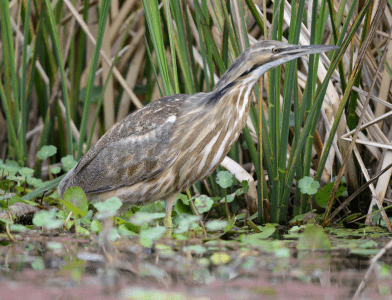
In my job I get to see what peoples’ favorite birds are and bitterns are definitely a crowd favorite! These American Bitterns are winter residents, while their smaller cousins are summer breeders. Therefore, the two species are always coming when the other is going. Not surprisingly, the species that breeds further north is the larger one. This is called Allen’s Rule, and is very often the case. n my job I get to see what peoples’ favorite birds are and bitterns are definitely a crowd favorite! These American Bitterns are winter residents, while their smaller cousins are summer breeders. Therefore, the two species are always coming when the other is going. Not surprisingly, the species that breeds further north is the larger one. This is called Allen’s Rule, and is very often the case.
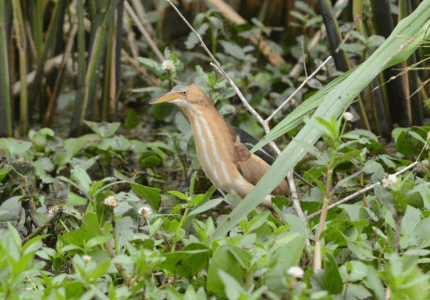
Least Bitterns prefer about the same habitat as their larger cousins on the previous page, although they very often are hanging onto the cattails with their unbelievably long toes. This species has a dagger bill like Royal and Sandwich, but they are the least and bit of a tern. BTW, back on the serious side (briefly), we once saw a Least Bittern flying in off the Gulf on a spring cold front, and it literally dropped dead right on the side of the coastal highway on Follet’s Island.
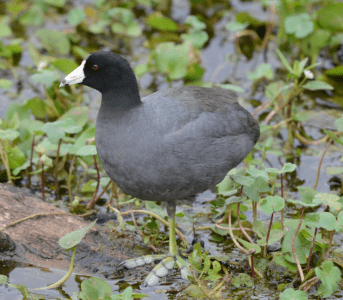
Coots are taken for granted but they are a really neat bird. They are rails and part of the trio of larger, out-in-the-open rails which also includes the gallinules and (former) moorhen. Coots join grebes and phalaropes as our only birds with lobed toes – the flat skin on each individual toe. Yes, I know “each individual” is redundant. Last, check out the vertical bill; this characteristic is shared by gallinules and moorhens.
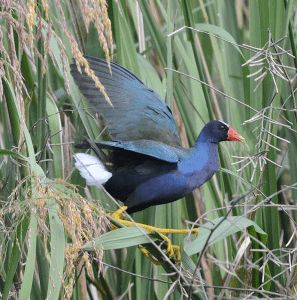
Gallinules don’t have any webbing or lobation on the toes, and Purples climb quite well. At BBSP, and especially over in Louisiana, Purples seek out seeds of bushes I can neither name nor talk about. Seeds are an underappreciated source of nutrients and energy for birds and often support the brightest of colors. My uncle in Alabama used to always eat seeds and he was most colorful. And seedy.
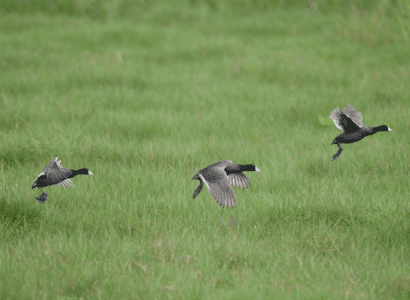
Coots are not great fliers and must take off by paddling across the water, like grebes, diving ducks, cormorants&Anhingas, and oceanic birds. But what this group lacks in take-off ability they make up for in endurance. Their dark meat – high in myoglobin – offers them great stamina and even allows the Purple Gallinule to fly across the Gulf!
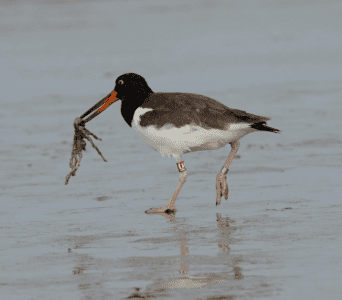
Oystercatchers eat (and try to eat) a wide variety of things, and here it’s trying to make a meal out of the Thalassia roots. I got excited at first coz I thought it was an animal!
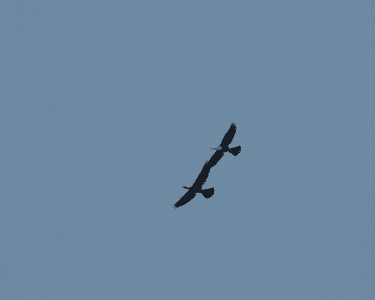
Here you see a pair of Anhingas in a rare glimpse of their courtship flight (over Brazos Bend State Park). This species is one of four in a family called darters, fish-spearing birds with thin, dagger bills and terrific swimming&diving ability. They are colloquially known as “water turkey” and “snake bird.” Fish ranchers have other names for them. :0-
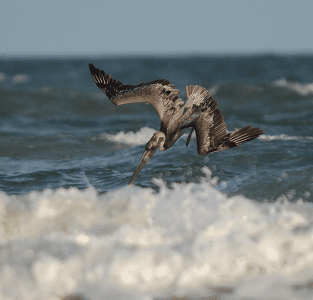
The pelicans shown at the end of Jurassic Park were a nice touch coz these birds go back many millions of years (though not quite to the Jurassic in their present form). Like their relatives, the boobies and gannets, they have air sacs in their chest feather bases which cushion the shock when they hit the water, p rotecting the viscera. Plus, immediately before they hit the water (remember, water is non-compressible) they straighten out their neck, so they easily zip right into the aquatic abyss.
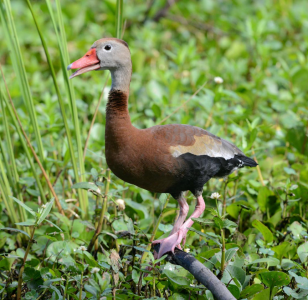
In the last 25 years or so we have definitely been invaded from the South! Part of this is probably the Earth warming but also, birds with burgeoning populations expand their ranges outwardly. These Black-bellied Whistling-ducks come from a group of tropical waterfowl found all the way across the Southern Hemisphere, and they don’t, BTW, quack like a duck
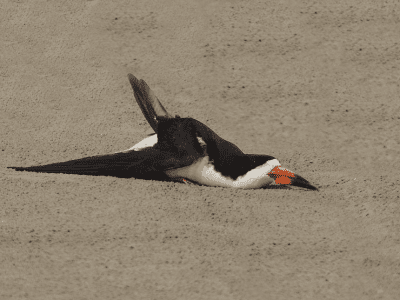
What do you do when you have a very heavy bill, skull and wings? You flop. Skimmers work hard feeding and they are due a good rest. But their propensity for beach flopping has led to many automobile casualties and because of this & other reasons, their numbers have dropped precipitously. Dow Chemical deserves a lot of credit for housing nesting skimmers on their parking areas.
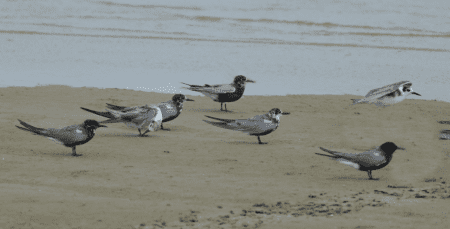
One of our loveliest birds is the Black Tern, a spring and ear ly fall visitor. Here you see an April flock of BLTEs in various stages of development, but all with the dark backs associated with their species. Curiously, you will rarely see them feeding around the Island as they seem to prefer foraging over the Intracoastal. Winter plumage below.
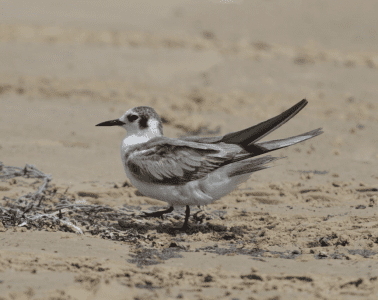
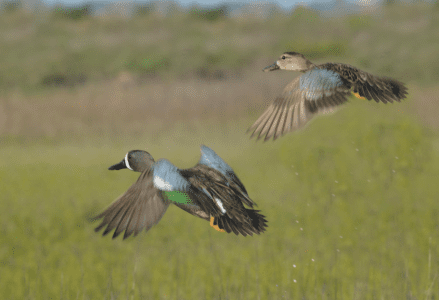
Our most abundant North American duck is the Blue-winged Teal, a small, fast-flying creature with a huge winter range. They winter all over the southern United States, but many actually go as far south as the northern part of South America. For much of the Spring they can be seen flying circum-Gulf (following the coastline), headed east off our shoreline. So what color is a Blue-winged Teal’s speculum?
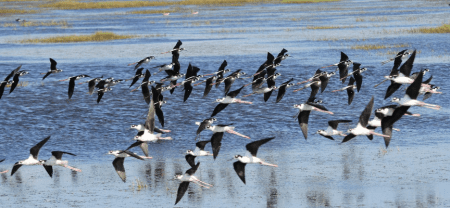
Here a flock of Black-necked Stilts arrives off the Gulf and is circling to find a good spot for resting and feeding. Stilts are not sandpipers, but actually in a family with avocets, named for their recurved bills. Note the lack of a white wing-stripe, a sure sign of this family. And I don’t care if you don’t like this shot – I love it! :0- Below is a flock of Blue-winged Teal also flying circum-Gulf. Note the saber-like wings, not unlike those of shovelers and pintail. If you look hard you can see the males’ white faces, though both sexes have the wing color. That’s a matter of a pinion. 😉
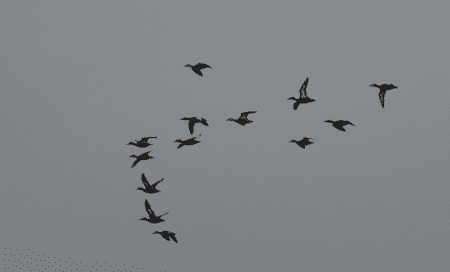
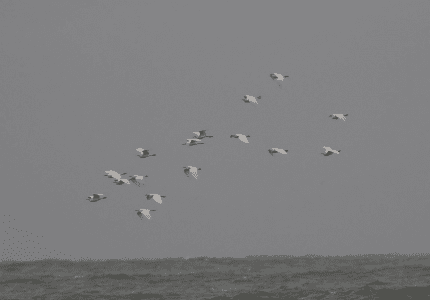
And not to belabor the point, but herons and egrets are big circum-Gulf migrators, as you can see these Cattle Egrets flying in from the Tropics. In fact, I have seen all our waders flying circum-Gulf except three. Least Bitters and Green Herons are trans-Gulf and our Reddish Egrets are virtually nonmigratory. I am reeeeeeeeally interested in c-G migra.
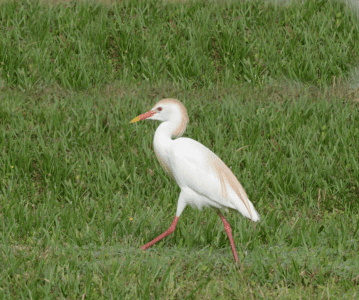
Cattle Egrets get pretty showy in their high breeding plumage, though, like most birds, their hbp only last a few days (or a coupla weeks). Breeding plumage lasts longer, of course, but it really takes a lot of energy to support the colors like the candy-corn on this Cattle Egret. Apparently, the opposite sex must really like it.
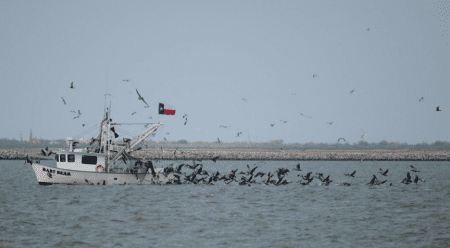
Fishing boats are excellent places to look for birds. From a distance you can see pelicans and gulls but up close you can often see other stuff. In the warm season (when I’m long gone) frigate birds follow these, robbing the other species of their hard-earned catch. This was off the Texas City Dike, an underrated place to bird (on weekdays!). God and His armies wouldn’t go there on the weekend.

The other day I was about to wax on eloquently with my clients, comparing the bills of the Caspian and Royal Tern, and I glanced at the gull to use as a size comparison for my people. For a moment, I couldn’t think which gull it was! Well, duuuuh, it was a CAGU – a California Gull! This lost bird represents the species that bailed out the Mormons at the Great Salt Lake when locusts were eating their crops. Er go, they became the State Bird of Utah, making them one of the neater State Birds in our Country. Having moved from FL to TX, I’ve had the mockingbird as “my” State Bird my entire life. Oh, joy.
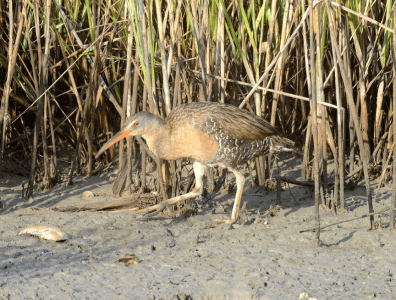
Clapper Rails are heard but not seen most of the year, but in late spring their hormones are flowing and they are emboldened to come out. Ecologically, they are separated from King Rails by their habitat choice of salt marshes, but their gray face is an excellent field mark. They are also not as richly colored as Kings.
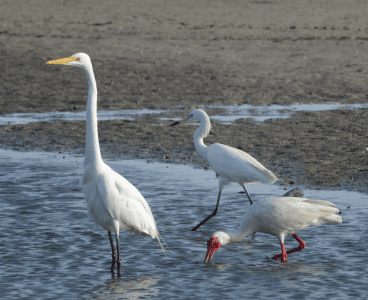
I’m sorry. I like this picture, and if you don’t I feel sorry for you! 😉 You got a White Ibis in high breeding plumage, a white morph Reddish Egret also in breeding plumage and a Great Egret who thinks he’s God’s gift to birders. I may have mentioned this but GREGs are the symbol for the National Audubon Society, and are about the only bird I can think of that’s had its name changed twice. It went from American to Common to Great.
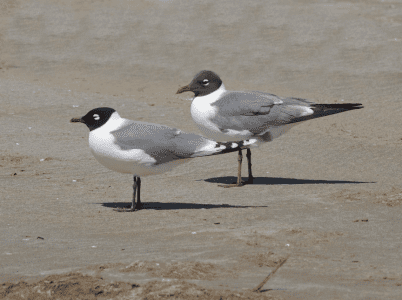
Did you realize this was two species? The ubiquitous Laughing Gull is on the right but the uncommon Franklin’s Gull is smaller and has large, white spots toward the ends of the wings. What’s really cool is when they arrive off the Gulf they often have a pinkish hue underneath from the pelagic shrimp they ate on the way across.
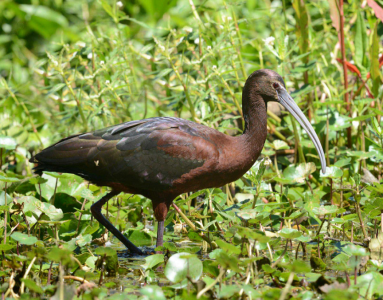
Our photography trip to Brazos Bend State Park was sweetened by this rare Glossy Ibis; a nice adult in breeding plumage. Notice how the bluish face only extends *to* the eye, not behind it. It also doesn’t have the reddish knees found on our ubiquitous White-faced Ibis, although the knees are obscured. Did you notice the fly on the wing coverts? 😉
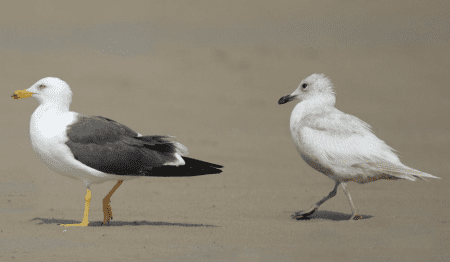
Every once in a while nature kisses us with something really exciting ( like the male Canada warbler I just shot). Above, you see the result of a quick trip to San Luis Pass, where there was an adult Lesser Black-backed Gull in full breeding plumage r ight beside a Thayer’s Gull, badly worn. Size is very important in gull identification, like knowing if the whitish bird were a bleached Herring, it’d be larger than the LBBG. OK, that’s enough. 😉

 Posted in
Posted in 
























